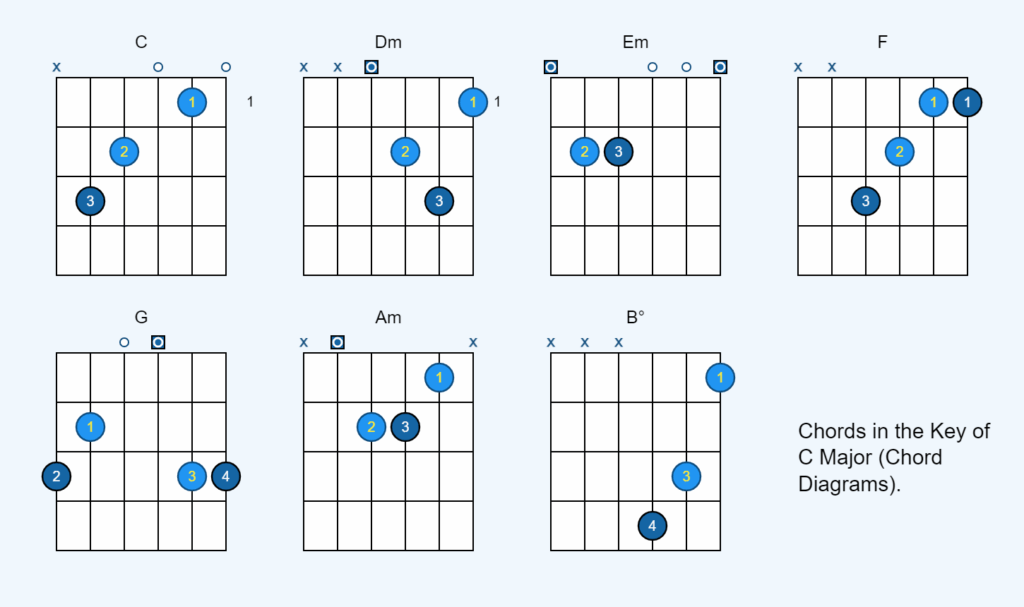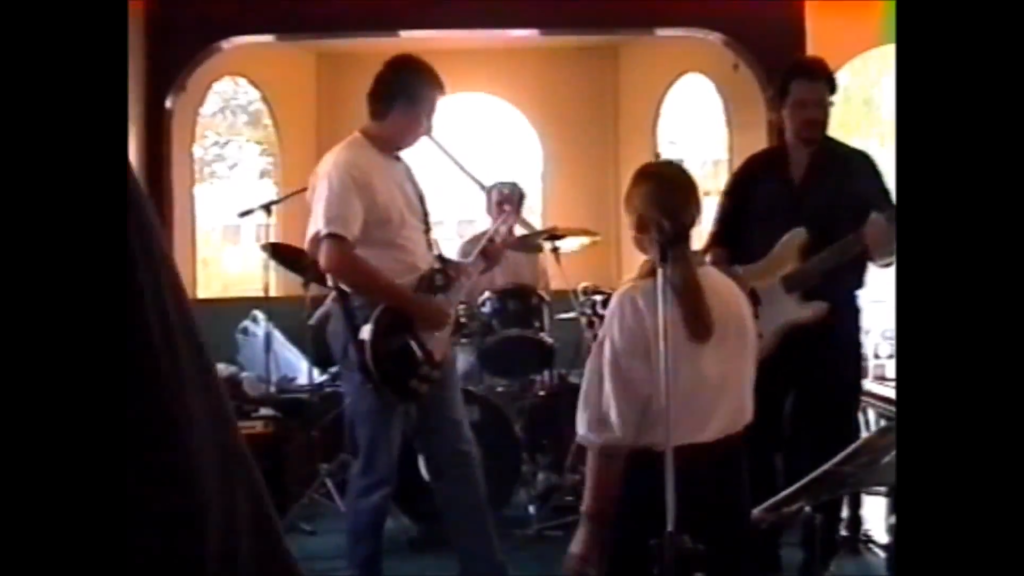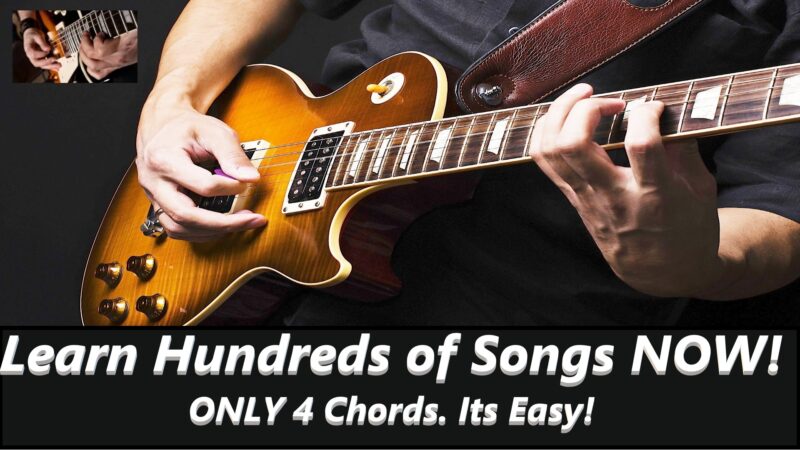Learn Hundreds of Songs with only 4 Chords. Its Easy!
Introduction
Have you ever been amazed by someone sitting down with a guitar and kicking into song after song seemingly effortlessly? Good news: you can join them. In fact, you can learn hundreds of songs with just four chords.
Yes, it’s that powerful and yes, it’s super easy. So let’s get started and have you impressing your friends immediately.
Understanding the Chords in a Key
Before we pick songs, let’s break down what we mean by “the chords in a key” we’ll use the key of C major for our example. What’s great about the Key of “C” is it has no sharp or flat chords so that’s super convenient.

In any major key you’ll have these chords built on each degree of the scale. Don’t worry this is super simple. The degree the the order the chords are listed.
The C Major chord is the First i.e.. 1st Chord where the F Major is the Fourth Chord and the G Major is the Fifth Chord in the Key. The 1st, 4th & 5th Chords or notes in a key are always Major. Major chords and notes sound happy for a lack of a better description.
The Second chord or note in a scale is Minor so we have a D Minor Chord as the 2nd Chord/Note in the scale. The sixth chord or note in a scale is also a minor so it sounds sad too. The sixth note in the C scale is A Minor as we see below.

Finally and most unimportantly because generally musicians starting out avoid the 7th Chord note in the scale as its a Diminished chord. In this case its a B Diminished Chord. I’m just going to ignore this for now as its not important for what we are learning.
- I (1) chord – the tonic → in C major = C major
- II (2) chord – the supertonic → in C major = D minor
- III (3) chord – the mediant → in C major = E minor
- IV (4) chord – the sub-dominant → in C major = F major
- V (5) chord – the dominant → in C major = G major
- VI (6) chord – the sub-mediant → in C major = A minor
- VII (7) chord – the leading-tone chord (in major key this is diminished) → in C major = B diminished
So in C major we have:
- I = C
- II = Dm
- III = Em
- IV = F
- V = G
- VI = Am
- VII = Bdim
(Note: In many pop/rock songs you’ll rarely use the VII diminished chord as a stable part of a 4-chord progression — often you’ll stick with I, IV, V, vi etc. But it’s good to know the full set.)
Which 4 Chords Unlock Hundreds of Songs?
In practice, many pop, rock and folk songs use just four chords repeatedly. One of the most common progressions is: I – V – vi – IV (in C major: C → G → Am → F).
Because so many songs sit on that progression (or variations of it like vi-IV-I-V), once you master those four chord shapes in one key you can play a surprising number of songs.
In the key of C major we’ll treat the four chords as:
- C (I)
- G (V)
- Am (vi)
- F (IV)
These four will form the backbone of our 50-song list below.
50 Popular Songs You Can Play With (Nearly) Only These 4 Chords.
Here are 50 songs many of them among the most recognisable pop/rock tunes that you can play using primarily the four chords C, G, Am, F (or in other keys the same shapes with a capo). (Note: Some songs may include extra chords or slight variations, but the main bulk uses those four chords.)
- “Don’t Stop Believin’” – Don’t Stop Believin’ by Journey
- “You’re Beautiful” – You’re Beautiful by James Blunt
- “Where Is the Love?” – Where Is the Love? by The Black Eyed Peas
- “Forever Young” – Forever Young by Alphaville
- “I’m Yours” – I’m Yours by Jason Mraz
- “Hey, Soul Sister” – Hey, Soul Sister by Train
- “Wherever You Will Go” – Wherever You Will Go by The Calling
- “Can You Feel the Love Tonight” – Can You Feel the Love Tonight by Elton John
- “Paparazzi” – Paparazzi by Lady Gaga
- “With or Without You” – With or Without You by U2
- “Let It Be” – Let It Be by The Beatles
- “Torn” – Torn by Natalie Imbruglia
- “She Will Be Loved” – She Will Be Loved by Maroon 5
- “Good Life” – Good Life by OneRepublic
- “Beat It” – Beat It by Michael Jackson (note: may have small variations but many parts playable)
- “Zombie” – Zombie by The Cranberries
- “Love Me Do” – Love Me Do by The Beatles
- “All of Me” – All of Me by John Legend
- “Grenade” – Grenade by Bruno Mars
- “Don’t Matter” – Don’t Matter by Akon
- “Let Her Go” – Let Her Go by Passenger
- “Say Something” – Say Something by A Great Big World
- “Wagon Wheel” – Wagon Wheel by Old Crow Medicine Show
- “Hall of Fame” – Hall of Fame by The Script featuring will.i.am
- “Price Tag” – Price Tag by Jessie J
- “What’s My Age Again?” – What’s My Age Again? by Blink‑182
- “U + Ur Hand” – U + Ur Hand by P!nk
- “Just a Dream” – Just a Dream by Nelly
- “Someone Like You” – Someone Like You by Adele
- “All Too Well” – All Too Well by Taylor Swift
- “Love the Way You Lie” – Love the Way You Lie by Eminem & Rihanna
- “Firework” – Firework by Katy Perry
- “Hot N Cold” – Hot N Cold by Katy Perry
- “Umbrella” – Umbrella by Rihanna
- “The Man Who Can’t Be Moved” – The Man Who Can’t Be Moved by The Script
- “Just Give Me a Reason” – Just Give Me a Reason by P!nk
- “Good Time” – Good Time by Owl City & Carly Rae Jepsen
- “Replay” – Replay by Iyaz
- “Make You Feel My Love” – Make You Feel My Love by Bob Dylan (popular version by Adele)
- “Beautiful” – Beautiful by James Blunt
- “One Day” – One Day by Matisyahu
- “If I Were a Boy” – If I Were a Boy by Beyoncé
- “Too Cool” – Too Cool by Meaghan Jette Martin
- “The Island” – The Island by Pendulum
- “Already Gone” – Already Gone by Kelly Clarkson
- “Save Tonight” – Save Tonight by Eagle Eye Cherry
- “Wrecking Ball” – Wrecking Ball by Miley Cyrus
- “Let Her Go” – (duplicate above) – but you could replace with “Breakeven” – Breakeven by The Script
- “Already Gone” – (duplicate above) – you could replace with “Somebody That I Used To Know” – Somebody That I Used To Know by Gotye
- “Don’t You Wanna Stay” – Don’t You Wanna Stay by Jason Aldean & Kelly Clarkson
(Note: you’ll want to check the original key and possibly use a capo or transpose to match your vocal range. The key thing: the chord shapes remain the same C–G–Am–F.)
The Axis Of Evil!
I forst was was made aware of this massive mix of songs using only 4 chords by a very popular Youtube video by a band called “The Axis of Evil”. They are a comedy music act and so Ill include the clip below so you can see immediately how easy this really is.
How to Use This in Practice
- Pick your guitar (or uke) and make sure you can play the four shapes: C, G, Am, F.
- Practice transitioning smoothly between them: C → G → Am → F, and also F → C → G → Am (because many songs vary the order).
- Choose a song from the list above. Check the original key and see if you can match it (or use a capo).
- Strum a basic rhythm (e.g., down-down-up-up-down-up) and play the four chords in loop while you sing the melody or lyrics.
- Once comfortable, try changing the order of the four chords (many songs use I–V–vi–IV, or vi–IV–I–V, etc.).
- When you’ve got one down, pick another song since you’re using the same shapes, you’ll learn faster.
- Impress your friends! Because you’ll be able to say “Hey, I can play that tune” with just four chords under your fingers.
Practice Song: “Don’t Stop Believin’” – Journey
Try this with the 4-chord pattern: C → G → Am → F
[C] Just a small town [G] girl [Am] Livin' in a lonely [F] world [C] She took the midnight [G] train Goin' [Am] anywhere [F] [C] Just a city [G] boy [Am] Born and raised in South De-[F]troit [C] He took the midnight [G] train Goin' [Am] anywhere [F] [C] A singer in a [G] smoky room [Am] The smell of wine and cheap per-[F]fume [C] For a smile they can [G] share the night It goes [Am] on and [F] on, and on, and on... [C] Strangers [G] waiting [Am] Up and down the [F] boulevard Their [C] shadows [G] searching in the [Am] night [F] [C] Streetlight [G] people [Am] Living just to [F] find emotion [C] Hiding [G] somewhere in the [Am] night [F]
🎸 Tip: Strum Pattern – Down, down, up, up, down, up. Keep a steady rhythm and loop the progression — it works through nearly the whole song!
Why This Works & Why It’s Surprising
– Because the four chords C, G, Am, F (or I-V-vi-IV) cover the tonic, dominant, and sub-mediant functions in the key, they give a strong harmonic foundation.
– Many songwriters favour this progression because it’s emotionally pleasing: it moves from home (I) to tension (V) to a little melancholy (vi) to resolution (IV) and back.
– It’s surprising because you might assume “hundreds of songs” means hundreds of chords, exotic shapes or advanced theory — but no, you just need four.
– As one site puts it: “There are tens of thousands of 4-chord songs … But if you’re looking to cover the most ground, the chord groups below have the highest return on investment (ROI).”
Final Words
So there you have it. You’re now equipped with:
- the full set of chords in the key of C major (I–II–III–IV–V–VI–VII)
- the four absolute most useful chords (C, G, Am, F) for unlocking a huge number of songs
- a list of 50 popular songs you can begin playing right now
Pick up your guitar, start strumming, pick your favourite tune from the list, and you’ll be impressing your friends in no time. Let’s get started!
💙 More to Explore
[Button links to related posts for internal site navigation – replace URLs as appropriate:]
- DreamingGuitar – Beginner Guitar Chords
- DreamingGuitar – Strumming Patterns You Need
- DreamingCoffee – How Coffee Fuels Creativity
- DreamingCoffee – The Best Coffee Gear for Musicians
- LetsFLyVFR – Flight Sim Tips for Beginners
- LetsFLyVFR – How Music Can Enhance Your Virtual Flight
The Author.

Brendon McAliece is a multi lingual expatriate Australian living in Thailand who speaks Thai, a number of its dialects and Lao. He has been playing guitar since he was 12 and continues to do so to this day.
He has performing in bands across the Middle East while contracting as a Aircraft Weapons Instructor with his 10 years of RAAF Armament Fitter experience and his maintained his love for playing guitar it continues to thrive today.

